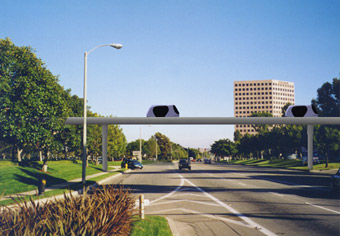

Far more likely to get off the ground than a solar-powered plane would be a photo-voltic zeppelin and, somewhat surprisingly, at least two companies already have designs in this area. The image above left is of the Strato-cruiser, a beautiful reimagining of the Zeppelin by Tino Schaedler, a London-based German set designer and thinker. It’s a wonderful flight of fancy designed to incorporate a gourmet restaurant, swimming pool and resident DJs and so on.
A less attractive, although far more prosaic redesign of the airship comes in the form of the US Aeroscraft, above right, a 400-ton hybrid airship, of which we are promised the first prototype later this summer. Powered by an electric motor, the airship has green credentials of its own. According to EcoGeek, such airships “do not require any energy to keep them aloft … Depending on their size, a modern airship could be significantly more energy efficient than even a Greyhound bus.” While Treehugger reckons that compared to a passenger jet of similar carrying capacity “it should require only half the fuel to operate.”
There’s more to this than meets the eye. According to Airship World that the Zeppelin is returning to the US after a gap of 70 years. The Zeppelin NT, the fourth to be sold by the German company, will be shipped to California later this year. Airships have been floated beforein recent years, but mostly as cargo vessels. This next-generation of dreamliners could have enough space for 1,000 people to sit comfortably on a lower deck, while an upstairs there could be tennis courts and movie theaters, well at least for those in first-class, that is.
 Cheers to Andrew for pointing me towards this map of the Brighton underground, by local artist Sean Sims, which is as witty and it is imaginative. Have a look at the bottom right-hand corner where you find the station for Beachy Head (terminus), a reference to its popularity for suicide, or towards the top where you will find that Crystal Palace is closed, a nod towards a bit of football team rivalry. Nice to see that Nick Cave has his own station too. It is a very good map, but not as good as this.
Cheers to Andrew for pointing me towards this map of the Brighton underground, by local artist Sean Sims, which is as witty and it is imaginative. Have a look at the bottom right-hand corner where you find the station for Beachy Head (terminus), a reference to its popularity for suicide, or towards the top where you will find that Crystal Palace is closed, a nod towards a bit of football team rivalry. Nice to see that Nick Cave has his own station too. It is a very good map, but not as good as this.




































Andrew Darling 8:10 pm on September 10, 2010 Permalink |
Think you mean cheers to @darlingbuds
black friday 9:48 pm on November 20, 2012 Permalink |
Hello There. I found your blog using msn. This
is a very well written article. I’ll make sure to bookmark it and come back to read more of your useful info. Thanks for the post. I will certainly return.